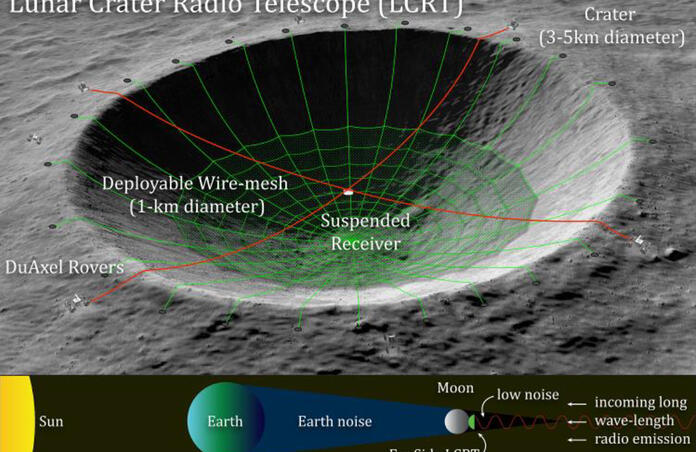NASA Unveils Plan to Turn Moon Crater into a Radio Telescope

NASA just unveiled one of its most ambitious plans yet—to build a giant radio telescope in a crater on the moon. The telescope, known as the Lunar Crater Radio Telescope (LCRT), would be 1 kilometer (3,281 feet) in diameter, making it the largest filled-aperture radio telescope ever created. Compared to telescopes on Earth, a lunar telescope would have a few distinct advantages. Though many are incredibly advanced, Earth-based telescopes suffer from a great deal of interference, from both radio communications from satellites and the Sun, and Earth's ionosphere itself. A lunar telescope would be free from these interferences, enabling the LCRT to observe the cosmos in a much higher range of wavelengths—wavelengths we have yet to explore.
The LCRT Project
LCRT was proposed by a team led by Saptarshi Bandyopadhyay, a robotics technologist at the Jet Propulsion Laboratory, California Institute of Technology. As previously mentioned, LCRT would be enormous—exactly twice the size of the largest radio telescope here on Earth, China’s Five-hundred meter Aperture Spherical Telescope (FAST). Bandyopadhyay writes in the proposal, “We propose to deploy a 1km-diameter wire-mesh using wallclimbing DuAxel robots in a 3-5km-diameter lunar crater on the far-side, with suitable depth-to-diameter ratio, to form a sphericalcap reflector. This Lunar Crater Radio Telescope (LCRT), with 1km diameter, will be the largest filled-aperture radio telescope in the Solar System!”

Aside from its incredible size, the telescope would be capable of observing far more than even the most powerful radio telescopes here on Earth. Since opening its doors, FAST has already discovered multiple fast radio bursts (FRBs), so the scientific possibilities of an unhindered radio telescope would be vast. “Such a telescope can observe the universe at wavelengths greater than 10m (i.e., frequencies below 30MHz), which are reflected by the Earth’s ionosphere and are hitherto largely unexplored by humans.” Bandyopadhyay further states that “LCRT could enable tremendous scientific discoveries in the field of cosmology by observing the early universe in the 10-50m wavelength band (i.e., 6-30MHz frequency band), which has not been explored by humans till-date.”
Next Steps
The LCRT is still in its very early stages of planning and development, but it was recently one of the multiple projects to receive grant money by NASA (up to $125,000). Bandyopadhyay and his team published a conceptual idea for this telescope back in 2018. As the abstract states, “We envisage that this concept would unlock the potential for ground-breaking scientific discoveries in radio astronomy.” Now that the team has access to some new funding, the LCRT’s development seems a real possibility.